
Heavy metal has been an ever-changing genre of music that has been around for over 50 years. It was introduced in the late '60s to early '70s, creating a genre that has been evolving and changing ever since. It's described and characterized as an aggressive genre that is driven by distorted guitar sounds, with complicated drum parts, and the continuous use of power chords. It first appeared in the United Kingdom and the United States, drawing influence from other genres such as blues, psychedelic rock, and acid rock. However, unlike those genres, this time the sound became thicker, heavier, and richer. Various bands took inspiration from jazz and simplified it, creating what we now know as Heavy Metal. These bands would include: The Yardbirds, Pink Floyd, The Doors, and Jefferson Airplane. But one band significantly stood out from the rest. They took a deeper and more focused approach to how they recorded. And their most popular album became one of the most influential albums in the world.
Black Sabbath is an English band, formed in Birmingham in 1968 by lead singer Ozzy Osbourne, guitarist Tony Iommi, bassist Geezer Butler, and drummer Bill Ward. The band cultivated a unique, dark and forbidding image, through their songs and while performing on stage. Whether or not Black Sabbath is the first heavy metal band is hard to say. But they were definitely one of the first, and they were able to break many records across the world with one of the most popular Heavy Metal albums to date... Paranoid!
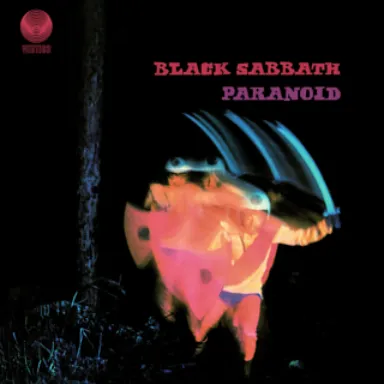
Black Sabbath became one of the pioneer bands who took the previous sound and made it different. With the release of their album 'Paranoid' in 1970, the band completely changed, and in a way created the sound of heavy metal. To this day, the album continues to be one of the most influential heavy metal albums of all time. As stated by NPR, it became "a genre-defining album".
The album contains eight songs, each filled with different strong emotions like rage or anger. The album took techniques from previous bands and changed them to create a new sound that was not heard before. The album also pushed the standard song length to over eight minutes and continuously used technology to amplify the dark and angry sound that the band was going for. Musical qualities used to describe 'Paranoid' would include the continuous use of tritones, ominous guitar riffs, and the use of the Devil's chords that also helped reinforce the dark atmosphere. On top of that, with the help of evolving technology, distortion and fuzz pedals became a crucial part of the guitar sound in the album, which again, paved a new path for the new bands that were to come after them.
It is hard to pinpoint an exact time and specific band who invented heavy metal, since there were multiple bands with heavier sounds that were becoming popular at the same time as Black Sabbath. But regardless of whether or not Black Sabbath was the first heavy metal band, they undoubtedly helped pioneer the sound of the genre with their album Paranoid, and this article will provide a deep understanding of how they accomplished it.
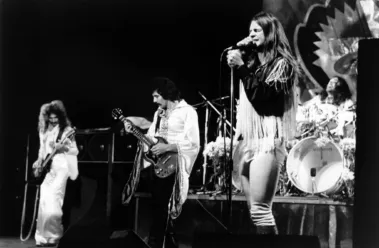
The Innovations That Influenced Heavy Metal
1970s Technology
One of the things that Black Sabbath adapted into their style was the technology they used. In the 70s, there was a major breakthrough in musical technology, which significantly helped create the dark and rich sound that the band produced.
The distortion and fuzz pedals became a significant item that every band at the time needed. This sound can be heard not only in Black Sabbath's music but also in other bands like Led Zeppelin and Deep Purple. The combination of both the distortion pedal and the use of high volumes became the definition of heavy metal (Poss 45-48).
Speaking of technology, another crucial element that heavy metal heavily relies on is the use of electric guitars. Looking back even further in history, the genre of blues laid the foundation for the electric guitar, with various bands using the clean electric guitar sound in their songs. Bands like Muddy Waters, Pat Hare, and T-Bone Walker laid the foundation for the development and use of the electric guitar in music (Ward 2012). The clean electric guitar sound can specifically be heard on the album T-Bone Blues.
Black Sabbath was able to take this clean electric guitar sound and, with the aid of technology, specifically distortion and fuzz pedals, manipulate the sound to make it deeper and richer. Every song on the album, except for Planet Caravan, uses a distortion pedal, which creates the deep, rich, and angry sound that characterizes heavy metal. Bands that came after Black Sabbath, like Iron Maiden or Slayer, also heavily rely on the use of distortion pedals in their songs. However, one of the reasons Black Sabbath is often considered the first heavy metal band is because they were one of the first bands to use this technology in their songs.
According to StudioD, guitarist Iommi not only relied on the use of his pedals but also on the sound created by his amplifiers. He mostly used two amplifiers - the 50-watt Marshall Plexi and the Laney LA 100 BL. As for his pedals, he had a custom pedal, which was the Dallas Rangemaster Treble Booster pedal. On the song Electric Funeral, he uses the pedal Tychobrahe Wah, which unfortunately is not made anymore; however, a wah pedal sound can be clearly heard used by the band Metallica in their song Enter Sandman (Glynn 2020) as well as many other popular bands today.
Later on in the decade, bands like The Who, Blue Cheer, Cream, and Iron Butterfly contributed to the sound even more by exploring dropped tuning, faster riffs, and fuzzier guitar sounds. An example of this would be the song 'Born To Be Wild' by Steppenwolf, which borrowed techniques from the biker culture and, for the first time in the history of music, used the words "heavy metal" in the lyrics of the song. In the album 'Paranoid', specifically in the song Iron Man, Iommi explored a very deep and fuzzy sound. Even in the guitar book, where the guitar comes in, it says "With effects" under measure 3 - something that was not notated before.

Listen to the opening guitar riff in the video below. You can hear a very similar guitar sound used by the band Beastie Boys in their song
‘Sabotage’, recorded 24 years after Paranoid was released.
String Gauge
Guitarist Tony Iommi can also be considered a pioneer of using lighter gauge strings. A tragic accident at a steel factory severed the tips of his fingers on his fretting hand, making it difficult for him to play with standard guitar strings. To overcome this challenge, he initially used thimbles like artificial fingertips whenever he played. Later on, lighter gauge strings became available to anyone, and they made various techniques, like string bending and faster picking, easier to play. These techniques can be clearly heard in all of the guitar solos played on the album. The song Paranoid, which uses a lot of fast picking, is easier to play with his prosthetic fingers. Iommi's doctor told him to forget playing the guitar; however, he did not give up and showed the rest of the world's musicians that it is possible to play the guitar with artificial fingertips.
Song Simplification
I found that newer bands tend to simplify their songs as much as they can. Take for example the three songs charted below, which have been, and continue to be very popular in the history of music.



As seen above, The Beatles heavily used continuous eighth notes. The first example is the song "Back in the USSR," which features repeated four-note chords throughout the song.
The next example is the song "Paranoid," which also relies on the use of eighth notes; however, unlike The Beatles, Black Sabbath employs tri-chords, also known as power chords, throughout the song. They simplified the four-note chords to give a heavier and deeper sound to the song without overcomplicating it. The chord is very easy and accessible to play on the guitar, making it great for any beginner to learn. The band was able to use fewer notes and still achieve a rich sound, thanks to the evolving technology. New amplifiers and guitar pedals, as previously mentioned, significantly helped make simple power chords sound richer and more interesting to listen to.
The last example is the song "Master of Puppets," which still heavily relies on the use of eighth notes. However, this time, Metallica completely eliminated chords, leaving only single notes in their guitar parts. They simplified the technique even more, and with the development of technology (again, fuzz and distortion pedals), the heavier guitar sounds allowed bands like Metallica to create the heavy metal sound without having to use power chords.
Without Black Sabbath paving the way with the use of technology, bands like Metallica would not have been able to incorporate this technology in their songs. However, with constant advancements in technology, bands can simplify their songs so much that they don't even need to play power chords to create the same rich sound.
Extended Song Length
The culmination of these sounds and techniques can be best seen in The Doors, who stand out from the other bands with their exceptional live musical performances, which often featured songs extending past the 10-minute mark - something that was uncommon for bands to do live (Prabhu 2018). This significantly changed the traditional length of songs performed on stage. The use of longer songs was then adopted by Led Zeppelin, with most of their hit songs being around 9 minutes long. For example, one of their most popular songs, "Kashmir," lasts 9 minutes and 41 seconds.
Black Sabbath also embraced this trend. As seen in one of their tracks on the album, "War Pigs / Luke's Wall," the song is 7:58 minutes long, well beyond the average 3-4 minute radio songs. The use of longer songs opened the door for many bands, as it allowed them to explore the form of their songs. A great example of bands that created longer songs after Black Sabbath would be Guns N' Roses, with their song "November Rain" being 9:17 minutes long. Black Sabbath paved the way for later bands since, before them, radio stations were reluctant to play longer songs. It is also worth mentioning that this song was heavily criticized by local radio stations due to its length. They even went as far as not streaming Black Sabbath's songs on the radio solely because of their length.
The Songs That Influenced Heavy Metal
Through the analysis of various individual songs off the album ‘Paranoid’, I am able to better demonstrate how various techniques are used to create the sound of heavy metal.
Planet Caravan
The chord progression consists of i-VII (or Em to D) - however to be more specific, Em to Emadd9 to D6add4 played in arpeggios. The i-VII progression is commonly used by Black Sabbath.

The song is based around the Em pentatonic blues scale with an added F#. It's almost like a hybrid scale. It also uses a Dorian mode. The lead parts are not usually fast or flashy; instead, they tend to be slower and simpler. Black Sabbath took inspiration from the blues and incorporated them into heavy metal, creating an original sound that captivated listeners. However, unlike heavy metal, jazz relied on the clean guitar sound that Black Sabbath completely transformed in their album.
Compared to the other songs on the album, the tempo and rhythm are both slower, rather than swinging. The song exudes a groovy, danceable feel. Since the vocals are very laid-back—soft and slow—this allows room for a guitar solo that leads the piece to its conclusion, using a blend of folk and blues styles and creating a fade-out towards the end of the piece.
The form of the song was quite uncommon for the rock genre at the time. Black Sabbath structured this song around the instrumental track, emphasizing a longer guitar solo that spanned the last 45 measures of the song.
Pink Floyd also adopted the extended length of their guitar solos and built upon that by featuring two or more long solos in their songs. An example of this would be the song "Comfortably Numb," which similarly emphasizes the instrumental aspect over the vocals. With the song being laid-back and slow, the first guitar solo is 10 measures long, and the second guitar solo extends for 28 measures.
War Pigs / Luke’s Wall
The song contains a two- chord power riff that intermittently plays during a tight hi- hat cymbal rhythm. Then, Ozzy comes in with the lyrics: “Generals gathered in their masses, just like witches at black masses” - dark lyrics, which were uncommon in the 60s and 70s. At the same time, guitar trills play along.

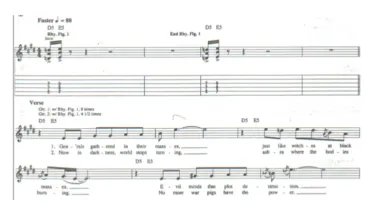
The song is eight minutes long, which is another example of Black Sabbath's use of extended song lengths. The drummer, Bill Ward, continuously plays drum fills throughout the first part of the song. Later, the song shifts to a metallic funk with a swing rhythm and a completely new, groovier riff. The guitar solo is played with a resonating open E string and is supported by a counter solo on the bass guitar that balances out and leads into a simpler verse that follows the solo.
However, the guitarist isn't finished, as a coda kicks in. This was because in the US, the track was considered too long and had to be split into two; the band chose to name the coda "Luke's Wall" (Dalley and Cheal 2018). The bright guitar line sets the tone and mood for a simpler, subsequent moshpit singalong, similar to the middle section of Metallica's "Master Of Puppets" or Iron Maiden's "Fear Of The Dark." In the end, due to the emergence of new technology, the song gets sped up, creating an unusual effect on the listener. Bands like Pink Floyd and Nine Inch Nails both use the same dark imagery in their songs.
The song is an excellent opener for the album, as it engages and involves the listener in the album as a whole. It starts out slow, with stoned-esque power chords in the introduction, before going silent. Then, Iommi starts playing D and E power chords, followed by a hi-hat rhythm. The drum rhythm is subsequently followed by the same D and E power chords.
Paranoid
The song consists of three chords, which are built off the 1st, 4th, and 5th scale degrees, and are all minor chords (E minor, A minor, and B minor), or the i, iv, v chords. The song begins with hammer-ons on the guitar, followed by the drums entering for a few bars. Next, the vocals join in. The post-verse section features sustained power chords, followed by the same verse riff with palm-muted quavers/8th notes and a cadence of heavy chords.

Iron Man
The main guitar riff is played using power chords, with the bass guitar doubling the root notes of the power chords an octave lower, creating a deeper sound for the song (diatonic B minor motive). To leave room for the vocals, the guitar plays only the root notes of the riff during the verse sections. The distortion, along with the voicing of the guitar and bass, as well as the drum part, contribute to the dense and angry heavy textures commonly found in metal music.
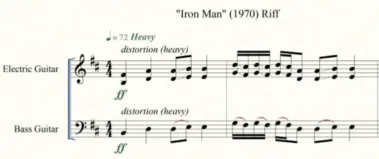
The song features various techniques like string bending. It is in 4/4 time and has a crotchet drum beat, which is quite similar to the drum beat in the song "Slow Ride" by Foghat. The song then transitions to vibrato-laden semibreves in F. Iommi plays a riff that has become one of the most recognizable riffs in history, with the chords B, D, D/E, E; G/F# G/F# G, D, D/E, E.
The song's influence on the heavy metal genre can be attributed to its heavy use of guitar effects. These guitar effects became crucial and defining for the heavy metal genre, with many bands continuing to use such effects in their songs to this day.
So, Was Black Sabbath the First Heavy Metal Band?

It's hard to definitively say that Black Sabbath was the first heavy metal band, especially with the presence of other greats like Led Zeppelin and Deep Purple. However, not only did Sabbath's album "Paranoid" become one of the first and most popular heavy metal albums to date, but it also arguably became one of the most influential on the heavy metal genre. With significant advancements in technology in the 60s and 70s, various bands started taking advantage of these opportunities to create something new—a sound that focused on experimenting with form and guitar techniques. Building on the trends appearing in songs by bands like Coven and Black Widow, Black Sabbath incorporated darker imagery, anger, and emotion into their album. With the release of "Paranoid," the band helped define the meaning of the genre and paved a path for bands that would follow.
Unlike the music by the previously mentioned bands, Black Sabbath's album was a heavy metal album from beginning to end. The continuous use of sludge tritone chords (the Devil's Interval) and power chords throughout the album by guitarist Iommi created an even darker, thicker, and sludgier sound. The interval produced an unsettling effect on the listener, making it almost uncomfortable to listen to. These effects were amplified by tuning the guitar down to a lower octave and bending the strings in a way that no other band had done before. Bassist Geezer Butler also doubled the dark guitar riffs, giving them an even heavier sound. The darkness was further intensified through the use of fuzz and distortion pedals, which were not as commonly employed at the time.
Although Black Sabbath didn't invent these techniques, they combined and popularized them, creating the sound of heavy metal. With the continuous use of these techniques throughout the album, Black Sabbath was able to create a new, heavier sound that changed the way music was made. This development paved the way for other sub-genres of metal to appear and take the music industry even further, creating new techniques and sounds, just like Black Sabbath did with their album "Paranoid." So, we may not know for sure if Black Sabbath was the very first heavy metal band, their influence and innovation with "Paranoid" undoubtedly played a pivotal role in shaping the genre.



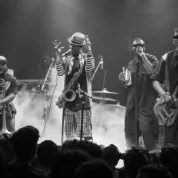


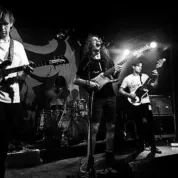
Leave a Reply!
No doubt they are the one's that spawned Heavy Metal
Is Ozzy still alive? That dude is out there!
My favorite band of all time :the_horns:
OMG Black Sabbath is the GOATl! They were the OGs of metal. So many other bands to come after them wouldn't be here. Their sound was just so heavy and epic for the 70s and you can still hear their influence in like every heavy metal band out there today. Sabbath is LIT! :the_horns:
Master of Reality is a better full album than Paranoid
Without a doubt the best rock band of all time. G.O.A.T.